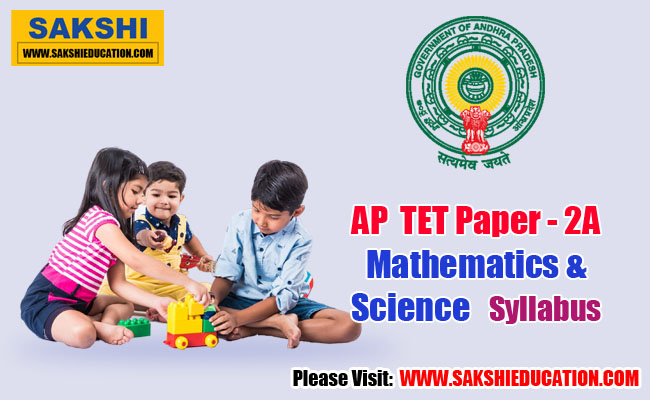AP TET Paper - 2A Mathematics and Science Syllabus

AP TET Paper - 2A Mathematics Syllabus Content (30 Marks)
Mathematics Content (24 Marks)
1.NUMBER SYSTEM
Numbers - Four fundamental operations (Addition, Subtraction, Multiplication, Division) - Knowing about Numbers - Hindu-Arabic system of numeration (Indian system of numeration) - International system of numeration (British system of numeration) - Place value and Face values of a digit in a number - Comparing and Ordering of Numbers - Whole Numbers - Factors and Multiples - Prime and Composite numbers - Even and Odd numbers - Tests for Divisibility of Numbers - Common Factors and Common Multiples - Prime factorisation - Highest Common Factor (G.C.D) - Lowest Common Multiple - Integers - properties and fundamental operations - Fractions and decimals - Types of fractions - comparison - Applications of fractions in daily life - four fundamental operations on fractions and decimals - Euclid's Division Lemma and its application - Rational Numbers - Properties of Rational Numbers - Representation of Rational Numbers on the Number line - Rational Numbers between two rational numbers - Four fundamental Operations on Rational Numbers – Rational numbers and their decimal expansions - Non-terminating, recurring decimals in rational numbers - Product of reciprocals - Squares - Square roots (Numbers and Decimals) - Properties of Square Numbers - Cubes - Cube roots of Numbers - Playing with Numbers - Games with Numbers - Letters for Digits - Irrational numbers - Real Numbers and their Decimal Expansions - Operations on Real Numbers - Laws of Exponents for Real Numbers – Properties & Laws of logarithms.
Sets and their representation (Roster form and Set builder form) – Classification of sets (Empty, Universal, subset, Finite & Infinite, disjoint sets) - difference of sets - Equal sets - Using diagrams to represent sets - Venn diagrams and cardinality of sets - Basic operations on sets (Union, Intersection).
2.ARITHMETIC
BODMAS rule - Ratios and Proportions (Direct, Inverse) - comparing quantities using ratios, proportion, percentage and their applications - Profit and Loss - Discount - Sales Tax/Value Added Tax/Goods and Services Tax - Simple, Compound Interest and their applications.
3.GEOMETRY
Basic geometrical concepts (Point, Line, Line segment, Ray, Curves, Polygons, Angles) - Measuring of Lines - Pairs of Lines - Intersecting Lines and Non-intersecting Lines – Lines parallel to the same line - Elements of Angles - Measuring of Angles - Types of Angles – Pairs of Angles - Naming of the given 2D figures of Triangles, Square and Rectangle - The Triangle - Types of Triangles and its Properties – Congruence and some properties of Triangles - Some more criteria for Congruence of Triangles – Criteria for similarity of triangles – Areas of similar triangles – Pythagoras theorem - Classification of Polygons - Angle sum property - Kinds of Quadrilaterals (Trapezium, Kite, Parallelogram) - Some special parallelograms (Rhombus, Rectangle, Square) - Constructing different types of Quadrilaterals - Views of 3D-Shapes - Identification of Edges, Vertices and Faces of 3D figures (Euler’s Rule) - Nets for building 3D shapes – Introduction to Euclid’s geometry – Euclid’s definitions, axioms and postulates - Angle Subtended by a Chord at a Point - Perpendicular from the Centre to a Chord - Equal Chords and Their Distances from the Centre - Angle Subtended by an Arc of a Circle - Cyclic Quadrilaterals – Tangents of a circle – Number of Tangent to a Circle from any point – Segment of a circle formed by a Secant.
4.STATISTICS
Reading and interpreting and analysing the Data (pictograph, tally marks, bar graphs, double bar graph, pie charts) - Graphical Representation of Data (Bar graphs, Histogram, Frequency polygons)
- Measures of Central tendency - Arithmetic Mean - Mode - Median of un-grouped, grouped data
- Graphical representation of cumulative frequency distribution – Ogive curves.
5. ALGEBRA
Patterns - making rules - The idea of variables - formation of algebraic expressions -Terms, Factors and Coefficients - Linear equations in one variable – Linear equations in two variables - Solutions of Pair of Linear Equations in Two Variables – Algebraic methods of finding the solutions for a pair of linear equations -Equations reducible to a pair of linear equations in two variables -Solution of a quadratic equation by factorisation & by completing the square – Nature of roots - terms and types of algebraic expressions - finding the value of an expression - Addition, Subtraction and Multiplication of Algebraic Expressions - Multiplying a Monomial by a Monomial and polynomial - Multiplying a Polynomial by a Polynomial - Standard Identities and their applications - Applications of simple equations to practical situations - Exponents and Powers - Negative exponents - Laws of exponents - Expressing large numbers in the standard form - Factorisation - Division of Algebraic Expressions Continued (Polynomial ÷ Polynomial) - Linear Graphs – Polynomials in one variable – Degree, Value, zeroes of a polynomial - Geometrical meaning of the Zeroes of a Polynomial - Graphical representation of linear, Quadratic and Cubic Polynomials - Factorisation of Polynomials
- Algebraic Identities - Working with Polynomials – Division algorithm for polynomials - Arithmetic progressions – Parameters of Arithmetic progressions – nth term of an Arithmetic progression – Sum of first n terms in Arithmetic progression – Geometric progressions – nth term of a GP.
6. MENSURATION
Measuring Length, Weight, Capacity, Time-Seasons, Calendar, Money, Area - Symmetry (Line and Rotational) - Perimeter of Triangle, Square, Rectangle, Rhombus, Trapezium, Parallelogram, Circle and Polygon, Properties of a Parallelogram - The Mid-point Theorem - Area of a Quadrilateral, Surface Area and Volume of Cube, Cuboid and Cylinder -Volume and capacity - Surface Area and volume of a Sphere - Volume of a Right Circular Cone – Surface area of the combination of Solids
- Volume of combination of solids – Conversion of solid from one shape to another -
7.PROBABILITY
Probability - Linking chances to probability - Chance and probability related to real life - Probability
- a theoretical approach - Mutually exclusive events - Finding probability - Complementary events and probability - Impossible and certain events - Deck of Cards and Probability – Use and Applications of probability.
8. CO-ORDINATE GEOMETRY
Cartesian System – Distance between two points – distance between two points on a line parallel to the co-ordinate axis – Distance between any two points on a line in the x-y plane – Section formula – centroid of a triangle – Tri-sectional points of a line – Area of the triangle – Heron’s formula- Collinearity – Straight lines – Slope of the straight line – slope of a line joining two points.
9. TRIGONOMETRY
Trigonometry – Naming the sides in a Right triangle – Trigonometric Ratios – Defining Trigonometric Ratios – Trigonometric ratios of some specific and complementary angles – Trigonometric identities – Applications of Trigonometry – Drawing figures to solve problems –solutions for two triangles.
Methodology (6 Marks)
- Meaning and Nature of Mathematics, History of Mathematics.
- Contributions of Great Mathematicians - Aryabhatta, Bhaskaracharya, Srinivasa Ramanujan, Euclid, Pythagoras, George cantor.
- Aims and Values of teaching Mathematics, Instructional objectives (Blooms taxonomy)
- Mathematics curriculum: Principles, approaches of curriculum construction, -Logical and
Psychological, Topical and Concentric, Spiral approaches. Qualities of a good Mathematics text book.
- Methods of teaching mathematics- Heuristic method, Laboratory method, Inductive and Deductive
- methods, Analytic and Synthetic methods, Project method and Problem Solving method.
- Unit Plan, Year Plan, Lesson Planning in Mathematics.
- Instructional materials, Edgar Dale's Cone of Experience.
- Evolving strategies for the gifted students and slow learners
- Techniques of teaching mathematics like Oral work, Written work, Drilling, Assignment, Project, Speed and Accuracy.
- Mathematics club, Mathematics structure, Mathematics order and pattern sequence.
- Evaluation - Types, Tools and Techniques of Evaluation, Preparation of SAT Analysis, Characteristics of a good test.
AP TET Paper - 2A PHYSICAL SCIENCE Syllabus Content (15 Marks)
Content (12 Marks)
1.MEASUREMENT
Story of transport, Non- standard units of Measurements, Measuring the length of a Curved line, Measurement of length, area, volume and time. CGS and SI units of length, area, volume and time, Conversion of units from CGS to S.I and Vice versa.
2.MOTION
Describing Motion, Motion and Rest, Motion Along a Straight Line, Types of motion (Translatory, Rotatory and oscillatory), Scalars and vectors, Distance, Displacement, Speed, Velocity, Average speed, Average velocity, Acceleration, Graphical Representation of Motion, Distance-Time Graphs, Velocity-Time Graphs, Uniform Motion and Non- Uniform Motion, Equations of Motion, Uniform Circular Motion, Laws of Motion, Balanced and Unbalance Forces, First Law of Motion, Inertia and Mass, Momentum, Second Law of Motion, Third law of motion.
3.FORCE, FRICTION AND PRESSURE
Force – A Push or a Pull, Exploring Forces, Effect of Force on Objects, Types of forces (field force and contact force), Net force, Types of friction (static, Sliding and Rolling), Factors affecting Friction, Friction: A Necessary Evil, Increasing and Reducing Friction, Fluid friction, Pressure,
Pressure Exerted by Liquids and Gases, Pressure of liquids at different depths, Atmospheric
Pressure.
4.GRAVITATION
Uniform circular motion, Universal law of gravitation, Free Fall, Acceleration due to Gravity, Motion of Objects Under the Influence of Gravitational Force of the Earth, Mass and Weight, Thrust and Pressure, Pressure in Fluids, Buoyancy, Floating and Sinking Objects, Archimedes’ Principle.
5.WORK, ENERGY
Scientific Conception of Work, Work Done by a Constant Force, Energy, Forms of Energy, Kinetic Energy, Potential Energy, Mechanical Energy. Law of Conservation of Energy, Conversion of Energy from one form to another, Power and its units.
6.SOUND
Sound - a form of energy, Production of sound, Some musical instruments, Sound Needs a Medium for Propagation, Human ear, Hearing Impairment, Noise and Music, Propagation of Sound, Types of waves (longitudinal and transverse), Characteristics of sound waves (Wavelength, Frequency, Time period, Speed of the wave), Relation between frequency and time period, Pitch, Loudness and Quality, Intensity of Sound, Speed Of Sound in Different Media, Reflection of Sound, Echo, Reverberation, Uses of Multiple Reflection of Sound, Range of Hearing, Infrasonic and Ultrasonics, Applications of Ultrasound, Sound pollution.
7.HEAT
Heat and temperature, Transfer of Heat (Conduction, convection, radiation), Kinds of clothes we wear in summer and winter, Units of temperature (centigrade, Fahrenheit and Kelvin; Conversions), Expansion of liquids due to heat, Types of thermometers, Thermal equilibrium,
Temperature and Kinetic energy, Specific Heat, Applications of Specific heat capacity, Principle of method of mixtures, Determination of Specific heat of a solid, Evaporation, Condensation, Humidity, Dew and Fog, Boiling, Latent heat of vapourisation, Melting, Latent heat of fusion, Freezing, Temperature- time graph.
8.LIGHT
Light, Transparent, Opaque and Translucent Objects, Shadows and Images, Rectilinear Propagation of Light, A Pinhole Camera, Regular and Diffused Reflection, Reflection of light by plane surfaces (laws of reflection, periscope, multiple images, kaleidoscope, Characteristics of
image formed by plane mirrors), Spherical Mirrors and Images, Spectrum, Wave nature of light,
Fermat principle, Sign convention, Refraction, Refraction of Light at Plane Surfaces, Refractive index, Absolute refractive index, Relative refractive index, Snell’s law, Critical angle, Total Internal Reflection, Applications of total internal reflection, Mirages, Optical fibres, Refraction Through a Glass Slab, Lateral shift, Vertical shift, Refraction of Light at Curved Surfaces, Lenses, Terminology used in the case of lenses -Focal length, Focus, Optic Centre, Principal axis, Radius of curvature, Centre of curvature, Focal plane, Behaviour of certain light rays when they are incident on a lens, Images formed by lenses for various distances of objects, UV method, Lens formula, Lens maker’s formula, Human Eye, Least distance of distinct vision, Angle of vision, Myopia, Hypermetropia, Presbyopia, Care of the Eyes, Braille System, Visually Impaired Persons, Power of lens, Refractive index of a Prism, Dispersion of light through prism, Sunlight-Dispersion, Rainbow, Scattering of light.
9.ELECTRICITY
Simple Electric circuit and its components, Conductors, Insulators, Type of cells (Dry and liquid), Electric symbols and uses, Series and parallel connection of cells and bulbs, Heating effects of Electricity, Understanding of CFL, Fuse and MCBs, Chemical Effects Of Electric Current, Good/Poor
Conducting Liquids, Electroplating, Magnetic Effects of Electric Current, Electromagnet, Electric bell, Electric current, Drude and Lorentz theory, Potential difference and EMF, Drift velocity and working of a cell, Ohm's law, Electric shock, Factors affecting the resistance, Series connection of
resistors, Parallel Connection of resistors, Multi-meter, Kirchhoff’s laws, Sign convention in a circuit, Electric power, Power consumption, Electric energy, Overload.
10.MAGNETISM AND ELECTROMAGNETISM
How Magnets were discovered, Magnetic and Non-Magnetic Materials, Types of Magnets, Poles of Magnet, Properties of Magnets, Storing magnets safely, Magnetic compass, Earth as a Magnet, Magnetic Induction, Oersted's experiment, Magnetic Field, Magnetic flux – Magnetic flux density, Magnetic field due to straight wire /circular coil/solenoid carrying current, Magnetic Force, Electric Motor, Electromagnetic induction, Faraday’s Law, Lenz Law, Applications of Faraday’s law of electromagnetic induction, Induced current, Induced EMF, Electric generator, DC and AC currents, rms values.
11.PRINCIPLES OF METALLURGY
Metallurgy, Occurrence of the metals in nature, Ores and Minerals, Extraction of metals, Activity series, Concentration or Dressing of the ore, Hand picking, Washing, Froth flotation, Magnetic Separation, Extraction of crude metal from the ore, Reduction of purified ore to the metal, Purification of the crude metal, Distillation, Poling, Liquation, Electrolytic refining, Corrosion,
Prevention of corrosion, Thermite process, Smelting, Roasting, Calcination, Flux, Gangue, Blast furnace, Reverberatory furnace.
12.CARBON AND ITS COMPOUNDS
Allotropes of Carbon, Amorphous forms, Crystalline forms, Diamond, Graphite, Buckminsterfullerene, Nanotubes, Versatile nature of Carbon, Catenation, Tetravalency, Hydrocarbons, Saturated and unsaturated hydrocarbons, Homologous series, Isomerism, Functional groups, Nomenclature of Aliphatic Hydrocarbons, IUPAC names, Chemical properties of carbon compounds- Combustion, Oxidation reactions, Addition reactions, Substitution reactions, Ethanol, Ethanoic acid, Esters, Esterification Reactions, Soaps – Saponification and Micelles, Cleansing action of soap, Detergents.
13.SOME NATURAL PHENOMENON
The Story of Lightning, charging by Rubbing, Electric charge and properties of electric charge, Types of charges and their interactions, Transfer of charge, lightning, lightning safety, lightning
conductors, Earthquake, Tsunami, Causes and effects, Protective measures.
14.STARS AND SOLAR SYSTEM
The Moon, The Moon’s Surface, Phases of Moon, Eclipses (Solar and lunar eclipses), The Stars,
Movement of Stars (Constellation, pole star), Movement of the sun, Solar System, Planets and
Some Other Members of the Solar System, Artificial Satellites.
15.CHANGES AROUND US
Slow/fast changes, Temporary/permanent changes, Natural/man made changes, Physical/ chemical changes, Rusting of iron, Crystallisation, Galvanization, Corrosion, Rancidity, Oxidation / reduction
16.MATTER
Objects Around Us, Properties of Materials, Physical Nature of Matter, Characteristics of Particles of Matter, States of matter, Properties of solids, liquids and gases, Change of state of Matter – effect of change of temperature and pressure, Evaporation, Factors Affecting Evaporation, Sublimation, Deposition, Boiling, Latent heat of vaporisation, Latent heat of fusion, Mixture, Types of Mixtures, Solutions., Properties of a Solution, Types of Solutions, Concentration of solution, Expressing Concentration of Solutions, Suspension, Properties of a Suspension, Colloidal Solution, Properties of a Colloid, Common examples of colloids, Mixtures, Methods of separation– handpicking, Threshing, Winnowing, Sedimentation, Decantation, Sieving, Filtration, Sublimation, Chromatography, Distillation and fractional distillation, Evaporation, Condensation, Use of more than one method of separation, Saturated and unsaturated solutions, Separation of immiscible liquids, Types of Pure Substances – Elements and Compounds.
17.ATOMS AND MOLECULES
Laws of Chemical Combination - Law of Conservation Of Mass, Law of Constant Proportions, Atom, Symbols of Atoms of Different Elements, Atomic Mass, Atomicity, Valency, Molecule, Molecules Of Elements, Molecules Of Compounds, Ion – Cation & Anion, Polyatomic ions, Names and symbols of ions, Formation of ions, Writing Chemical Formulae, Molecular Mass, Molar mass, Formula Unit Mass, Structure of The Atom, Subatomic particles, Charged Particles in Matter, Thomson’s Model of an Atom, Rutherford’s Model of an Atom, Bohr’s Model of an Atom, Bohr-
Sommerfeld model of an atom, Neutrons, Distribution of electrons into different Orbits, Atomic Number and Mass Number, Isotopes, Isobars, Atomic line spectra, Planck’s quantum theory, Quantum numbers, Shapes of orbitals, Electronic Configuration, Pauli Exclusion Principle, Aufbau principle, Hund’s Rule.
18.CLASSIFICATION OF ELEMENTS-THE PERIODIC TABLE
Dobereiner’s law of Triads, Newlands’ law of Octaves, Mendeleev’s Periodic Table, Modern Periodic Table, Periodic properties of the elements and their gradation in the modern periodic table.
19.CHEMICAL BONDING
Lewis dot structures, Covalency, Electronic theory of valence by Lewis and Kossel, Octet rule, Ionic and Covalent bonds, Ionic and Covalent compounds, Bond lengths and Bond energies of covalent bonds, Valence shell electron pair repulsion theory, Valence bond theory, Hybridisation.
20.METALS AND NON METALS
Physical Properties of Metals and Non-metals, Chemical Properties of Metals and Non-metals, Uses of Metals and Non-metals, Examples of metals and non-metals, Reactivity order of metals.
21.SYNTHETIC FIBRES AND PLASTICS
Natural and Synthetic fibres, Preparation and uses, Types of Synthetic Fibres, Characteristics of Synthetic Fibres, Plastics as Materials of Choice, Types of plastics, Plastics and environment,
Biodegradable – Non biodegradable materials.
22.COAL AND PETROLEUM
Exhaustible and inexhaustible Resources, Fuels – Types, Coal, Story of Coal, Uses of Coal and Coal products, Refining of petroleum, Petrochemical products in various sectors, Various Constituents of Petroleum and their Uses, Formation of coal and petroleum, Natural Gas, Misuse of Energy
resources and Consequences.
23.COMBUSTION FUELS AND FLAME
Combustion, Types of Combustion, Ignition temperature, Inflammable substances, Flame, Fuel Efficiency, Burning of Fuels Leads to Harmful Products, Fire control, Structure of flame – colors zones – Intensities.
24.AIR
Atmosphere, Components of air, Availability of oxygen to plants and animals, Replacement of Oxygen in the Atmosphere.
25.ACIDS, BASES AND SALTS
Natural acid-base indicators, Synthetic acid-base Indicators, Olfactory indicators, Universal Indicator, Chemical properties of Acids and Bases, Reaction of Acids and bases with Metals, Reaction of Acids with carbonates and metal hydrogen Carbonates, Neutralization reaction, Reaction of Acids with metal oxides, Reaction of base with non-metal oxide, Production of H+ions and OH- ions, Electrical conductivity of Acids and Bases, Properties of Bases, Dilution, Strength of acid or base, pH scale, Importance of pH in everyday life, Self defense by animals and plants through chemical warfare, Family of salts, pH of Salts, Chemicals from common salt, Important
product from chlor-alkali process and their uses, Water of crystallization, Common salt, Bleaching Powder, Baking soda, Washing soda, Plaster of paris, Gypsum, and their uses.
Methodology (3 Marks)
- Definition, Nature, Structure and History of Science
- Aims, Values, Instructional Objectives of teaching Science and Academic Standards in Science
- Methods of Teaching Science
- Teaching Learning Material in Teaching of Science - TLM in Science – Use of ICT.
- Instructional Planning
- Science Laboratory
- Science Teacher - Changing Roles
- Science Curriculum and its transaction, NCF-2005, SCF- 2011
- Science Textbooks.
- Evaluation - CCE - Formative Assessment, Summative Assessment - Designing and Administration Analysis of Scholastic Achievement Test (SAT)
AP TET Paper - 2A BIOLOGICAL SCIENCE Syllabus Content (15 Marks)
Content (12 Marks)
- LIVING WORLD
Living and Nonliving things, Characteristics of living organisms, Different types of habitat and adaptation, Skeletal parts – Bones, Joints, Cartilage; muscles, Movements in animals, Cell – The basic unit of life, Types of cells, Cell structure and function, Cell division, Animal Tissues, Plant tissues, Introduction to microorganisms, Useful Microorganisms, Harmful microorganism, Food preservation, Agricultural Practices, Improvement in crop yields, Storage of food, Food from Animals - Animal Husbandry
- LIFE PROCESSES
Our food, Components of food, Balanced diet, Malnutrition, Deficiency diseases, Plants – Types, Plant parts – functions, Types of nutrition, Nutrition in plants – Autotrophic, Parasitic, saprophytic, Insectivorous; Nutrition in animals - Different ways of taking food, Digestion in humans, Digestion in grass eating animals, feeding and digestion in amoeba; Cellular respiration, Types of respiration, Respiration in plants, Respiration in animals, Respiration versus combustion, Photosynthesis versus Respiration, Circulatory system - Human Circulatory system, Evolution of the transport system in animals, Transportation in plants; Excretion - Excretion in Human Beings, Excretion in other organisms, Excretion and release of substances in plants, Excretion Vs Secretion; Coordination in animals- Nervous and Endocrine systems, Control mechanism in plants – Plant hormones, tropic and nastic movements, Modes of reproduction – sexual, asexual and vegetative; Sexual reproduction in plants, Seed dispersal, Sexual and Asexual Reproduction in Animals, Metamorphosis, Reproduction in a placental mammal – Man, Reproductive health, Birth control methods, Fighting against social ills, Adolescence and puberty – changes, role of hormones, Reproductive phase, Variations, Mendel’s experiments on inheritance, Sex determination in human beings, Evolution – Lamarckism, Darwinism, Evidences of evolution, Human evolution
- OUR ENVIRONMENT
Our Environment - Food chain, Food web, Ecological pyramids, Effects of human activities on ecosystems, Steps towards prevention; Natural resources - Renewable and non-renewable resources, conservation; Bio diversity - Forests, Flora, fauna, interrelation of organisms, Advantages of forests, Deforestation - effects, Conservation of forest and wildlife – Protecting areas, endangered and endemic species; Air & water pollutions -Cusses, effects and prevention, Water, Sewage, Treatment of polluted water, Better housekeeping practices, Sanitation and Disease, Alternative arrangement for sewage disposal; Global Environmental Issues - Green house effect, Global warming, Acid rains; Nitrogen cycle.
Methodology: (3 Marks)
- Definition, Nature, Structure and History of Biological Science
- Aims, Values, Instructional Objectives of teaching Science and Academic Standards in Science
- Methods of Teaching Science
- Teaching Learning Material in Teaching of Science - TLM in Science – Use of ICT.
- Instructional Planning
- Science Laboratory
- Science Teacher - Changing Roles
- Science Curriculum and its transaction, NCF-2005, SCF- 2011
- Science Textbooks.
- Evaluation - CCE - Formative Assessment, Summative Assessment - Designing and Administration Analysis of Scholastic Achievement Test (SAT)








